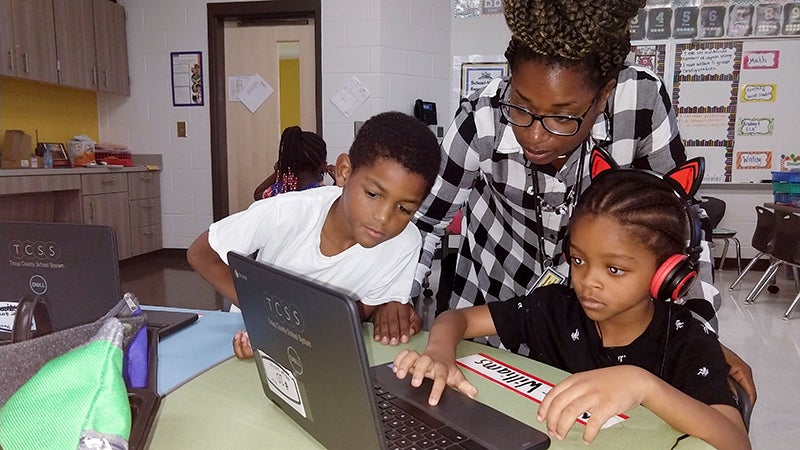Chromebook initiative places digital technology into the hands of 6,000 students
Published 7:59 pm Friday, September 28, 2018
Beginning Oct. 1, the Troup County School System will begin distributing roughly 6,000 Chromebooks to middle and high school students in conjunction with their focus on one-to-one learning.
The Chromebook Initiative was approved by the Board of Education in June. While the concept of classroom learning via Chromebooks is not new, now, students in grades six through 12 will be assigned a device they can use at school and also take home.
“As a board, we know our students are living in an environment surrounded by technology,” said Kirk Hancock, chairman of the TCSS BOE. “The decision to implement one-to-one technology goes hand-in-hand with how students access information today. Providing them their own personal Chromebook will enable them to leverage this technology to the fullest which can enhance their academic success.”
“Our students will be able to learn their way and in a variety of settings — in the classroom, at the coffee shop and at home. By providing every student their own device, we help to level the playing field while trying to make learning more relevant and accessible to the student,” Hancock said.
The call for more digital learning in classrooms came in 2015 with Senate Bill 89. It was then the governor signed the bill that encouraged schools to “(by July 2015) purchase all instructional materials and content in digital or electronic format… (and) provide a laptop, tablet or other wireless electronic device to each of its students in grades three and higher.”
Joshua Moneypenny, the TCSS’s director of technology, said this project not only meets the recommendations set forth by SB89, but it is also part of the TCSS strategic plan developed two years ago. With funding provided by Education SPLOST, the district has been preparing for the $2.75M investment for a number of years.
There was work to be done to execute phase two of the plan though.
“Before rolling out the Chromebooks, there were a number of steps we needed to take to ensure successful implementation,” Moneypenny said. “In Phase I, we had to decide what devices were best for student use. We also surveyed each principal to assess individual school needs. Furthermore, we had to prepare our employees for the rollout — what it would look like in the classroom from a learning perspective and how it was going to be fully implemented.”
The chosen device was a Dell 5190 2-in-1 Chromebook. Moneypenny said the devices will come fully loaded with Google Suite technology. This will provide each student access to Google Classroom and school assignments from the comfort of their own home. As a part of internet safety precautions, the device will also include software that prevents students from accessing non-school related sites.
“Anytime a student tries to access a site, it will run through TCSS filters just like it would if they were sitting in a classroom,” Moneypenny said.
Each student will be supplied a Chromebook with a carrying case and charging adapter. It will have touchscreen and tablet capabilities. The devices will also include a unique serial number and the new TCSS logo. When students are assigned a Chromebook, their name will be associated with that number.
“This creates a sense of accountability, ownership and equity,” Moneypenny said. “Students will receive the same Chromebook each school year. They will sign an acceptable use agreement and have their picture taken when they check out the device. They will then be responsible for the care of their assigned device. In addition, all students will have access to devices to increase digital learning and creativity.”
Is there something parents must complete to ensure their child receives a Chromebook device? Moneypenny noted that campus administration at each middle and high school has sent a Chromebook Use Form home with students.
Parents or guardians must sign the TCSS agreement, and the student must return the form to obtain their Chromebook.
That’s it.
“Digital empowerment is something we embrace as a school system. In preparing our students for success, we know they need to have access to digital technology,” Moneypenny said of the TCSS focus on technology. “For years, we have taught our students digital citizenship and appropriate learning when it comes to digital responsibility. Now, we are taking it a step further with the implementation of the Chromebook initiative.”
From a TCSS teacher perspective, Lindsey Trinrud has used Chromebooks for math instruction in her LaGrange High classroom.
“Over the past year, I have been using Chromebooks in my classroom,” Trinrud said. “There have been many visible benefits to my students. It has allowed me to better meet the needs of my students where they are because technology better allows me to assess my students. They receive timely and specific feedback. They communicate with me based on the feedback, and they take action to achieve mastery (of the subject). … One-to-one technology has given my students, and myself, many advantages. The biggest one is that it has brought back a bit of fun, excitement and enjoyment in the classroom.”




